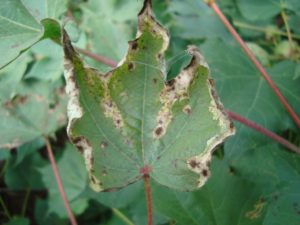by Jason Woodward, Associate Professor and Extension Plant Pathologist
Recent weather conditions throughout much of the state have been extremely conducive for the development of Alternaria leaf spot. Numerous outbreaks of the disease have been reported from the High Plains and Rolling Plains over the past several growing seasons. In recent years, the disease has been routinely observed in cotton late in the season with several factors affecting severity. Initial symptoms of the disease consist of small circular lesions that may expand up to half an inch. Margins of lesions have a distinct purple color. As the disease progresses lesions may coalesce, turn dull gray and crack, exhibiting a shot-hole appearance. Severe defoliation can occur rapidly when heavy rainfall is received and extended periods of high humidity and cooler temperatures are experienced. The fungus can readily be observed on dead and dying tissues as black, sooty masses of spores. Although, infections can occur on the cotyledons of seedlings, the disease is most commonly observed late in the growing season and affect mature or senescing tissue in Texas. Under such conditions, increased disease severity has been observed on earlier maturing and/or large seeded varieties, as well as in fields with a heavy boll load. These factors are presumably attributed to potassium deficiencies in the leaf at the time of infection, as potassium is being moved out of the leaf into the boll to fill out developing seeds. Impacts on yield in this region are poorly understood, but are generally believed to be minimal as occurrences are late in the season. Several fungicides registered for use in cotton, such as Headline and Quadris, include Alternaria leaf spot on their label; however, applications should be made in a preventative manner. At this time, there is no information on the efficacy of these products applied to cotton for management of Alternaria leaf spot curatively. Likewise, the application of foliar potassium will do little to correct the problem, as infections are believed to be the result of a transient deficiency and not a soil deficiency as is seen in other cotton producing regions. Risk of the disease in subsequent years is possible, as the fungus can survive on crop debris in the soil, thus residue management through tillage may limit production of inoculum in the field. If you have any questions regarding this or any other cotton diseases contact your local County Extension office, or you can contact Jason Woodward via e-mail (jewoodward@ag.tamu.edu) or phone (806-632-0762).

Associate Professor and Extension Plant Pathologist
Dept. of Plant Pathology and Microbiology
Texas A&M AgriLife Research
Lubbock, TX
806-746-6101
jewoodward@ag.tamu.edu


